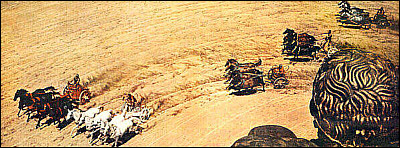 |


TechnoFILE is copyright and a registered trademark © ® of
Pandemonium Productions.
All rights reserved.
E-mail us Here!

Long Live Black Bars!Letterboxing Gives You Bang for the Buck By Jim Bray Those black bars bracketing some of the video movies you watch mean you’re getting the most out of your movie dollar. Readers often express concerns to me about “those infernal black bars” above and below the picture and why they infest so many DVD’s, laserdiscs, and some VHS tapes. They’re worried that there’s something wrong with their TV or player. There’s nothing wrong. In fact, there’s something very right. When movies were new, they were shot and displayed with an “aspect ratio” (the ratio of the picture’s width to its height) of 1.37:1. Decades later, the people who dreamed up television chose 1.33:1 as the shape of the idiot box’s screen. With the increasing popularity of television in the 1950’s, the movie industry needed a weapon with which to fight the upstart medium and convince the public to continue putting its collective bums into theater seats. Among various gimmicks tried, including stereo sound and 3D, the most successful was widescreen. You might even say it changed the shape of motion pictures, though I would never stoop so low as to make such an awful pun. Different methods of widescreen were tried, including processes that actually used multiple cameras and projectors to put different parts of the image onto a huge, curved screen. You may remember names like CinemaScope, VistaVision, Cinerama, and, of course, Panavision. All were different widescreen technologies, though all but Panavision have virtually disappeared over the past forty years or so. Most movies are now shot with an aspect ratio of either 1.85:1 or 2.35:1, which means they’re substantially wider than they are tall. Since TV still uses the old aspect ratio of 1.33:1, it’s okay for showing old 1.37:1 movies, but compromises have to be made to get the rectangular widescreen image onto the basically square TV set. Until the rise in popularity of laserdisc as a “moviephile’s medium,” virtually all movies-on-TV-or-video were released in what’s referred to as “Pan & Scan.” This is where the technician converting the film to video would focus the “transferring machine” onto a squarish section of the picture, moving it from side to side to follow the action or dialog. Sometimes they wouldn’t “pan” at all, which could lead to important parts of the picture being left off altogether from the video transfer. So while the picture fit the TV from top to bottom, the widescreen picture’s sides were being sliced off. Look at it this way: the widest widescreen movies (1959’s “Ben-Hur” is a great example) could lose nearly half their picture when cropped to fit the TV. This is one heck of a dirty trick to pull on a director’s vision, and it hamstrings some of the greatest movies ever made. Take Ben-Hur’s chariot race, for instance. The “Pan & Scan” version loses so much image that it almost seems as if Charlton Heston’s driving a mere pair of horses, while the widescreen version (often called “letterboxed” in video parlance) not only shows the entire four horse team, but you can follow its progress as Heston steers them by, through, and around other teams. Likewise, when you see a widescreen version of “The Music Man,” the school board magically transforms visually from a barbershop trio into the full barbershop quartet. The apparent downside, of course, is those black bars. Fitting a widescreen presentation onto a square TV screen means “zooming back” until the sides of the widescreen picture fit onto the TV screen. This leaves the top and bottom of the TV screen unused and blank, hence the “bars.” As annoying as they may be, however, the presence of those bars is a sign that you’re gaining the extra image the film’s director had always intended for you to see, but which the old style of video conversion stole right out from under your unsuspecting eyes. Once widescreen and high definition TV become popular, both of which feature a 16x9 (1.78:1) aspect ratio that’s close to the 1.85:1 used by movie makers, the “black bar problem” won’t be as severe. Until then, just imagine as you squint at that narrow band of picture across the middle of your TV screen, that you’re sitting at the back of a big movie theater – and take joy in the knowledge that you’re getting everything you were meant to, and more bang for your buck. Jim Bray's technology columns are distributed by the TechnoFILE and Mochila Syndicates. Copyright Jim Bray.
|
|
|
| Support TechnoFile via Paypal |
| TechnoFILE's
E-letter We're pleased to offer our FREE private, subscription-based private E-mail service. It's the "no brainer" way to keep informed. Our Privacy Policy |